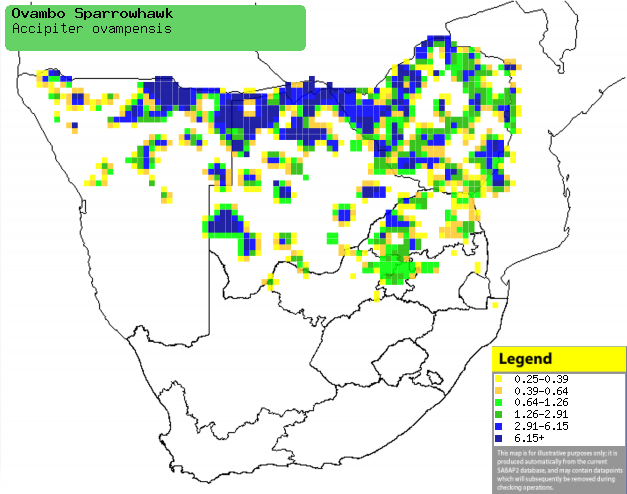|
Accipiter ovampensis (Ovambo
sparrowhawk)
Ovambosperwer [Afrikaans]; Kakodi (generic term for
sparrowhawks, goshawks, kestrels and falcons) [Kwangali]; Rukodzi (generic
name for a small raptor such as falcon or sparrowhawk) [Shona]; Phakalane,
Segôôtsane (generic terms for some of the smaller raptors) [Tswana];
Ovambo-sperwer [Dutch]; Épervier de l'Ovampo [French]; Ovambosperber
[German]; Gavião do Ovambo [Portuguese]
Life
> Eukaryotes >
Opisthokonta
> Metazoa (animals) >
Bilateria >
Deuterostomia > Chordata >
Craniata > Vertebrata (vertebrates) > Gnathostomata (jawed
vertebrates) > Teleostomi (teleost fish) > Osteichthyes (bony fish) > Class:
Sarcopterygii (lobe-finned
fish) > Stegocephalia (terrestrial
vertebrates) > Tetrapoda
(four-legged vertebrates) > Reptiliomorpha > Amniota >
Reptilia (reptiles) >
Romeriida > Diapsida > Archosauromorpha > Archosauria >
Dinosauria
(dinosaurs) > Saurischia > Theropoda (bipedal predatory dinosaurs) >
Coelurosauria > Maniraptora > Aves
(birds) > Order: Falconiformes
> Family: Accipitridae
> Genus: Accipiter
Distribution and habitat
Occurs in patches of sub-Saharan Africa; in southern Africa it is rare to
locally common in the northern half of Namibia (including the Caprivi Strip),
Botswana, Zimbabwe and north-eastern South Africa. It generally favours tall
woodland with patches of bare ground, such as riverine and broad-leaved
woodland, with miombo (Brachystegia), Mahobohobo (Uapaca kirkiana)
or Zambezi teak (Baikiaea plurijuga).
|
 |
|
Distribution of Ovambo sparrowhawk in southern Africa,
based on statistical smoothing of the records from first SA Bird Atlas
Project (©
Animal Demography unit, University of
Cape Town; smoothing by Birgit Erni and Francesca Little). Colours range
from dark blue (most common) through to yellow (least common).
See here for the latest distribution
from the SABAP2. |
Predators and parasites
It has been recorded as prey of Accipiter melanoleucus
(Black
sparrowhawk).
Movements and migrations
Mainly sedentary, although there is evidence to
suggest that it might make local movements, as its occurrence is
seasonal in some areas.
Food
It exclusively eats birds, hunting in a manner that more
closely resembles falcons than it does other sparrowhawks and goshawks. It usually hunts
by flying quite high above the ground, looking for prey, then stooping to chase
the animal near the ground for up to
about 100-200 metres. The following food items have been recorded
in its diet:
Breeding
- Monogamous, territorial solitary nester, with the female doing most of the
construction of the nest, which consists of a stick platform lined with bark
chips and sometimes green leaves. It is typically placed in the canopy of
a tree, such as the following:
- alien trees
- Eucalyptus
- Populus (poplars)
- indigenous trees
- Brachystegia glaucescens (Mountain-acacia)
- Kirkia acuminata (White kirkia)
- Julbernadia globiflora (Munondo)
- Uapaca kirkiana (Mahobohobo)
- Acacia nigrescens (Knob thorn)
- Celtis africana (White-stinkwood)
- Egg-laying season is from August-November, peaking from
August-September.
- It lays 1-5 eggs, which are incubated solely by the female for about
37-39 days, while the male feeds her at the nest 2-3 times per day.
- The chicks are fed with food provided by the male for the first 18 days,
after which the female starts to help him hunt. They leave the nest at about
33-39 days become fully independent roughly a month later.
Threats
Not threatened, in fact its range has increased due to the
introduction of alien trees, which it uses for nesting. It has also benefited
from the abundance of
birds associated with agriculture to feed on.
References
-
Hockey PAR, Dean WRJ and Ryan PG 2005. Roberts
- Birds of southern Africa, VIIth ed. The Trustees of the John Voelcker
Bird Book Fund, Cape Town.
|
